Afghanistan’s defence and security forces face enormous challenges. They are countering an insurgency of well-equipped guerrilla fighters, who enjoy the unconditional support of organised crime, international terrorists and some neighboring countries. They are on the front line of the fight against terrorist groups including Al-Qaida, so-called Islamic State and the Haqqani Network. Moreover – as Afghan President Mohammad Ashraf Ghani has said repeatedly – for fourteen years Afghanistan has been in an undeclared war with Pakistan. And it’s also believed that the country continues to be the proxy battleground for India and Pakistan, two nuclear powers.
It is essential that the international community continues to stand by Afghanistan, building up the capacity of its forces and sustaining them financially until the country is able to do so itself. Not only is this support vital for Afghanistan, it is also in the strategic interest of its international partners.
A proud military destroyed
Afghanistan is no stranger to conflict. It has suffered numerous civil, regional and cross-regional wars over the past three millennia. The security and defence of the country depended on militias for a long part of its history but started to develop its formal military in the tenth century, during the Ghaznavid Empire.
By the 1980s, Afghanistan had a small, but strong military. As a landlocked and mountainous country, it depended heavily on its air force for transport, reconnaissance and close air support. It had more than 400 aircraft, including around 240 fixed-wing combat aircraft, 150 helicopters and perhaps 40 transport aircraft.
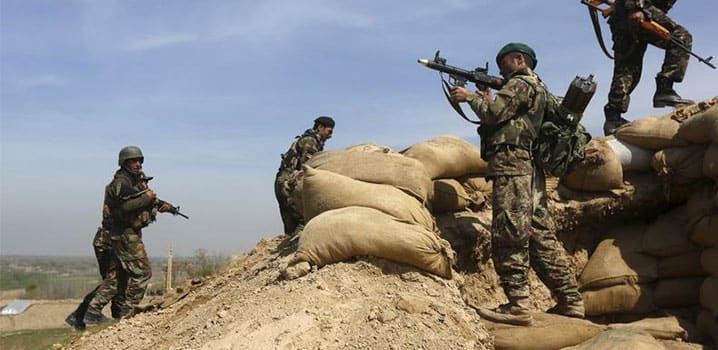
Afghan security forces countering the insurgency take their positions on a hilltop in Baghlan province in March 2016. © REUTERS
The country’s proud aviation history was symbolised by Abdul Ahad Momand, an Afghan air force aviator who was the first Afghan – and the fourth Muslim – to journey to outer space as one of Soyuz TM-6 crew members and spent nine days aboard the Mir space station in 1988 as an Intercosmos Research Cosmonaut.
These achievements were erased and most military assets were looted and destroyed during decades of war and internal conflict, before the international community intervened following the 9/11 terrorist attacks.
Starting from scratch
In August 2003, NATO took command of the International Security Assistance Force (ISAF), mandated by the United Nations (UN). Over the following decade of ISAF’s deployment, building up the Afghan national security and defence forces became an increasingly important part its mission.
This meant starting from scratch. Afghanistan’s military assets had been destroyed. Moreover, the UN-led Disarmament, Demobilization and Reintegration programme disarmed around 100,000 of the mujahedin and officers of the former communist regime -- and many were excluded from serving in the Afghan security forces.
With time it became clear that disarming the militia groups and excluding professional military officers – along with ISAF’s extremely centralised security and governance strategy – provided an opportunity for the Taliban and terrorists to re-emerge and re-organise in the rural areas of Afghanistan.
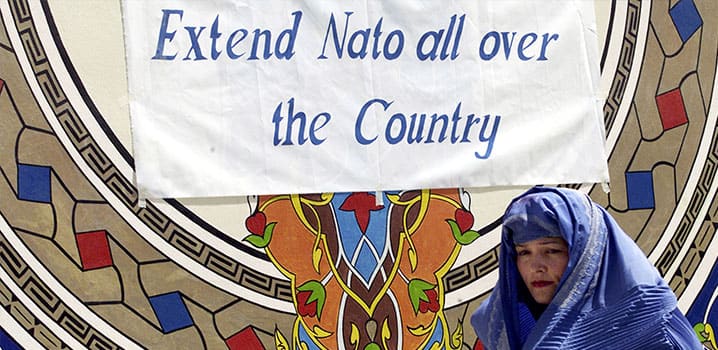
In early August 2003, with NATO poised to take command of the international peacekeeping force in Afghanistan, an Afghan woman walks past a sign in Kabul calling on the force to be expanded beyond the capital. © REUTERS
Resistance and casualties increased. Eventually, under the command of General Stanley McChrystal, ISAF adopted a counterinsurgency strategy in 2009. This called for more ISAF troops to push back the Taliban, while also placing a greater focus on training and building up the Afghan security forces so that they would be able to secure their own country eventually.
By the time that ISAF had completed the gradual transition of responsibility for security to the Afghan authorities before ending its mission in December 2014, Afghanistan had around 352,000 well-trained soldiers and police – an impressive achievement. ISAF also underpinned other vital progress in Afghanistan, helping provide the security and space for democracy to take root, institutions and infrastructures to be rebuilt, thousands of schools to be reopened, free media to thrive, and the country to recover its international recognition.
Lack of leadership
Of course, the insurgency was not defeated by the end of the ISAF mission. The challenges of insecurity and instability facing Afghanistan remain immense and its national security forces will require long-term international support both financially and in terms of capacity building.
The Afghan security sector has come a long way in terms of quantity but it is time to focus on quality and in-depth security sector reform. The Afghan security forces lack strong political and military leadership at all levels as well as the resources to fight hybrid warfare. The position of defense minister has been vacant since mid 2014. Moreover, reform of the ministry of interior has lagged.
Nevertheless, Afghan forces have proved to be fierce fighters against the terrorists and insurgents. Beyond expectations – and against the many predictions that civil war would follow the transition of security to Afghan lead – they have been defending their nation with courage and honor.
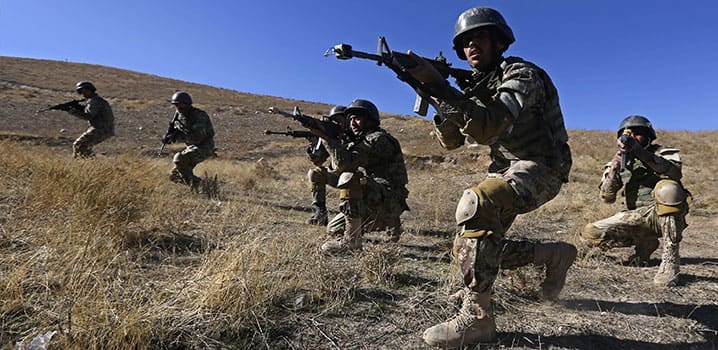
Afghan National Army soldiers take part in a training exercise at a military base in Kabul in November 2014. © REUTERS
The focus now should be on nurturing educated, professional and well-trained officers and non-commissioned officers. Leadership development, gender mainstreaming and accountability mechanisms in the security ministries should be prioritised. Afghanistan also needs to develop the capacity of young officers and soldiers to replace the older generation in the defence and security forces. Moreover, it is time to professionalise the police and draw greater distinctions between the duties of law enforcement and the military.
Blood and treasure
Afghanistan’s costly, bloody and lengthy war has exhausted the taxpayers of donor countries and troop contributing nations. There is no exact figure for the costs incurred by the international coalition during the war. However, the United States on its own has committed around US$113 billion since 2002 for the reconstruction and support of Afghanistan. And the human cost has been high: as of end February 2016, 3515 coalition members and tens of thousands of Afghan security forces and civilians have died.
Yet, NATO and the wider international community have renewed their commitments to support Afghanistan for another decade. NATO and its partners launched a new train, advise and assist mission (‘Resolute Support’) in January 2015. Wider cooperation with the Alliance is also being taken forward through its Enduring Partnership programme with Afghanistan. The United States and Afghanistan have also agreed a long-term partnership framework and a bilateral security agreement.
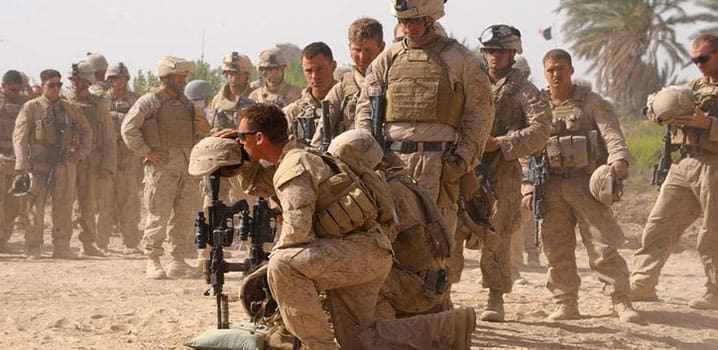
A US Marine says goodbye to his fallen friend during a memorial service in Helmand Province in 2009.
NATO and its partners committed – at NATO’s 2012 Summit in Chicago – to provide financial support to sustain the Afghan forces until the end of 2017 and are currently working to ensure support through 2020. Already, since 2007, NATO Allies and partners have donated around US$430 million per year to the NATO-Afghan National Army Trust Fund.
Afghanistan’s partners want to secure the investments of blood and treasure they have already made to help the country get back on its feet. Reconciliation and a peace deal are the best options to end the war but – until a settlement is reached – the deteriorating security situation and the growing terrorist threats require the continued engagement of NATO Allies and partners in Afghanistan.
It is also in their own strategic interest to remain engaged.
Strategic choice
As a landlocked country neighboring China, Pakistan, Iran and Central Asian countries, Afghanistan has significant geostrategic and geopolitical importance. It is the only country in the region which gives open access to the United States and NATO Allies. The Khyber Pass, located between Afghanistan and Pakistan, has long been one of the most important trade routes and strategic military locations in the world. Moreover, the Silk Road passes through Afghanistan. This ancient network of trade routes, 4000 miles long, is known as the cultural crossroads of the Indian, Persian and Chinese civilisations. Insecurity and instability in Afghanistan would destabilise the region and provide fertile ground for terrorist groups, posing a threat to Allies and partners.
Afghanistan also faces immense economic and development challenges. The country is rich in natural resources, gas, minerals and oil (worth more than a trillion US dollars according to some estimates). But insecurity and war has limited opportunities to explore and extract these resources, and Afghanistan remains among the poorest countries of the world. Combined with insecurity, lack of economic opportunities are driving many Afghans to flee the country. According to the office of the UN High Commissioner for Refugees, more than a quarter of the one million refugees and migrants who arrived in Europe in 2015 were Afghans (coming second after Syrians). Helping Afghanistan establish peace and to grow its economy could help stem the flow of refugees, which represents a brain drain for Afghanistan and also risks destabilizing the European Union.
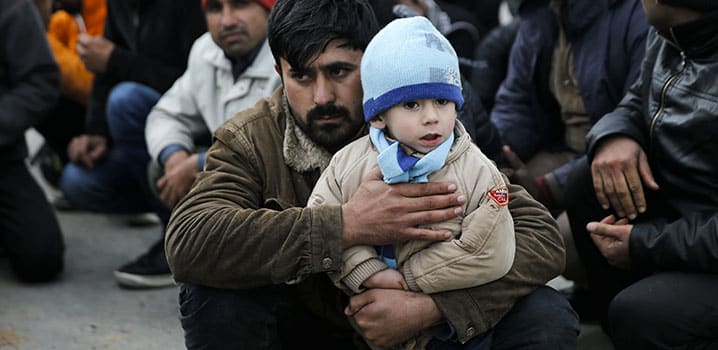
An Afghan migrant holds his son after arriving at a port on the Greek island of Lesbos, after having been rescued at sea by the Greek Coast Guard in March 2016. © REUTERS
So, it is well worth sustaining investment in the development of Afghanistan as well as its security forces. The year 2017 is just around the corner. Setting an exit date for the NATO-led Resolute Support Mission and the US presence may help the Afghan security forces to take responsibilities – but it also helps the Taliban narrative of “you may have the watches, but we have the time”. NATO’s upcoming summit meeting in Warsaw in July 2016 is an opportunity for NATO and its partners to renew their commitment to long-term support for the further development of the Afghan security sector. It is in the interest of both the Allies and Afghan people.
